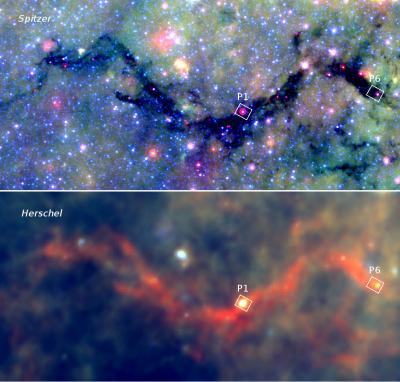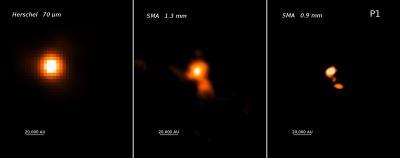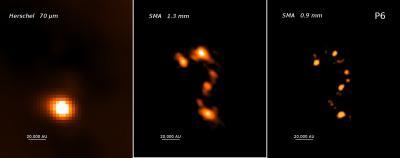The Smithsonian's Submillimeter Array (SMA) telescope has providec the most detailed view yet of stellar nurseries within the Snake nebula and what they found lends new insight into how cosmic seeds can grow into massive stars.
Stretching across almost 100 light-years of space, the Snake nebula is located about 11,700 light-years from Earth in the direction of the constellation Ophiuchus.
In images from NASA's Spitzer Space Telescope it appears as a sinuous, dark tendril against the starry background, thus the name. It was targeted in the new study because it shows the potential to form many massive stars - stars that are 8 times heavier than our Sun.

The Snake nebula as photographed by the Spitzer and Herschel space telescopes. At mid-infrared wavelengths (the upper panel taken by Spitzer), the thick nebular material blocks light from more distant stars. At far-infrared wavelengths, however (the lower panel taken by Herschel), the nebula glows due to emission from cold dust. The two boxed regions, P1 and P6, were examined in more detail by the Submillimeter Array. Credit: Spitzer/GLIMPSE/MIPS, Herschel/HiGal, Ke Wang, European Southern Observatory
"To learn how stars form, we have to catch them in their earliest phases, while they're still deeply embedded in clouds of gas and dust, and the SMA is an excellent telescope to do so," explained lead author Ke Wang of the European Southern Observatory (ESO), who started the research as a predoctoral fellow at the Harvard-Smithsonian Center for Astrophysics (CfA).
The team studied two specific spots within the Snake nebula, designated P1 and P6. Within those two regions they detected a total of 23 cosmic "seeds" - faintly glowing spots that will eventually birth one or a few stars. The seeds generally weigh between 5 and 25 times the mass of the Sun, and each spans only a few thousand astronomical units (the average Earth-Sun distance). The sensitive, high-resolution SMA images not only unveil the small seeds, but also differentiate them in age.

The P1 star-forming region within the Snake nebula. The left panel shows a far-infrared view from the Herschel space telescope. Submillimeter views from the Submillimeter Array are at center and right. The sensitive, high-resolution Submillimeter Array images reveal small cosmic 'seeds' spanning less than a tenth of a light-year, which will form one or a few massive stars. Credit: Herschel/EPoS, Sarah Ragan (MPIA); SMA, Ke Wang, European Southern Observatory
Previous theories proposed that high-mass stars form within very massive, isolated "cores" weighing at least 100 times the mass of the Sun. These new results show that that is not the case. The data also demonstrate that massive stars aren't born alone but in groups.
"High-mass stars form in villages," said co-author Qizhou Zhang of the CfA. "It's a family affair."
The team also was surprised to find that these two nebular patches had fragmented into individual star seeds so early in the star formation process.
They detected bipolar outflows and other signs of active, ongoing star formation. Eventually, the Snake nebula will dissolve and shine as a chain of several star clusters.

The P6 star-forming region within the Snake nebula. The left panel shows a far-infrared view from the Herschel space telescope. Submillimeter views from the Submillimeter Array are at center and right. The sensitive, high-resolution Submillimeter Array images reveal small cosmic 'seeds' scattered in the shape of a question mark. Each seed will form one or a few massive stars. Credit: Herschel/EPoS, Sarah Ragan (MPIA); SMA, Ke Wang, European Southern Observatory






Comments